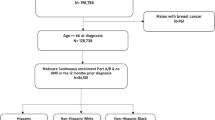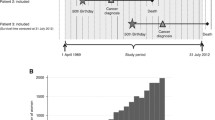Summary
Background
Disparities in cancer survival may be related to differences in stage. Segregation may be associated with disparities in stage, particularly for cancers for which screening promotes survival.
Objectives
The objective of the study was to examine whether segregation modifies racial/ethnic disparities in stage.
Design
The design of the study was analysis of Surveillance, Epidemiology, and End Results Medicare data for seniors with breast, colorectal, lung, and prostate cancer (n = 410,870).
Measurements and main results
The outcome was early- versus late-stage diagnosis. Area of residence was categorized into 4 groups: low segregation/high income (potentially the most advantaged), high segregation/high income, low segregation/low income, and high segregation/low income (possibly the most disadvantaged). Blacks were less likely than whites to be diagnosed with early-stage breast, colorectal, or prostate cancer, regardless of area. For colorectal cancer, the black/white disparity was largest in low-segregation/low-income areas (black/white odds ratio [OR] of early stage 0.51) and smallest in the most segregated areas (ORs 0.71 and 0.74, P < .005). Differences in disparities in stage by area category were not apparent for breast, prostate, or lung cancer. Whereas there were few Hispanic–white differences in early-stage diagnosis, the Hispanic/white disparity in early-stage diagnosis of breast cancer was largest in low-segregation/low-income areas (Hispanic/white OR of early stage 0.54) and smallest in high-segregation/low-income areas (OR 0.96, P < .05 compared to low-segregation/low-income areas).
Conclusions
Disparities in stages for cancers with an established screening test were smaller in more segregated areas.


Similar content being viewed by others
References
Fried VM, Prager K, MacKay AP, Xia H. Chartbook on Trends in the Health of Americans: Health, United States, 2003. Hyattsville, MD: National Center for Health Statistics; 2003.
Ries LAG, Eisner MP, Kosary CL. SEER Cancer Statistics Review, 1973–1999. Bethesda, MD: National Cancer Institute; 2002.
Wong MD, Shapiro MF, Boscardin WJ, Ettner SL. Contribution of major diseases to disparities in mortality. N Engl J Med. 2002;347(20):1585–92.
Clegg LX, Li FP, Hankey BF, Chu K, Edwards BK. Cancer survival among US whites and minorities: a SEER (Surveillance, Epidemiology, and End Results) Program population-based study. Arch Intern Med. 2002;162(17):1985–93.
Ragland KE, Selvin S, Merrill DW. Black–white differences in stage-specific cancer survival: analysis of seven selected sites. Am J Epidemiol. 1991;133(7):672–82.
Eley JW, Hill HA, Chen VW, et al. Racial differences in survival from breast cancer. Results of the National Cancer Institute Black/White Cancer Survival Study. JAMA. 1994;272(12):947–54.
Optenberg SA, Thompson IM, Friedrichs P, Wojcik B, Stein CR, Kramer B. Race, treatment, and long-term survival from prostate cancer in an equal-access medical care delivery system. JAMA. 1995;274(20):1599–605.
Bach PB, Schrag D, Brawley OW, Galaznik A, Yakren S, Begg CB. Survival of blacks and whites after a cancer diagnosis. JAMA. 2002;287(16):2106–13.
Oakley-Girvan I, Kolonel LN, Gallagher RP, Wu AH, Felberg A, Whittemore AS. Stage at diagnosis and survival in a multiethnic cohort of prostate cancer patients. Am J Public Health. 2003;93(10):1753–9.
McCarthy EP, Burns RB, Coughlin SS, et al. Mammography use helps to explain differences in breast cancer stage at diagnosis between older black and white women. Ann Intern Med. 1998;128(9):729–36.
Sassi F, Luft HS, Guadagnoli E. Reducing racial/ethnic disparities in female breast cancer: screening rates and stage at diagnosis. Am J Public Health. 2006;96(12):2165–72.
Li CI, Malone KE, Daling JR. Differences in breast cancer stage, treatment, and survival by race and ethnicity. Arch Intern Med. 2003;163(1):49–56.
Lannin DR, Mathews HF, Mitchell J, Swanson MS, Swanson FH, Edwards MS. Influence of socioeconomic and cultural factors on racial differences in late-stage presentation of breast cancer. JAMA. 1998;279(22):1801–7.
Lantz PM, Mujahid M, Schwartz K, et al. The influence of race, ethnicity, and individual socioeconomic factors on breast cancer stage at diagnosis. Am J Public Health. 2006;96(12):2173–8.
Shavers VL, Brown ML. Racial and ethnic disparities in the receipt of cancer treatment. J Natl Cancer Inst. 2002;94(5):334–57.
Agency for Healthcare Research and Quality. US Preventative Services Task Force. Accessed January 29, 2008, at http://www.ahcpr.gov/clinic/uspstfix.htm.
American Cancer Society. Cancer Facts and Figures. American Cancer Society; 2006. Accessed January 29, 2008, 2006, at http://www.cancer.org/downloads/STT/CAFF2006PWSecured.pdf.
Bach PB, Jett J, Pastorino U, Tockman MS, Swensen SJ, Begg CB. Computed tomography screening and lung cancer outcomes. Jama. 2007;297(9):953–61.
Henschke CI, Yankelevitz DF, Libby DM, Pasmantier MW, Smith JP, Miettinen OS. Survival of patients with stage I lung cancer detected on CT screening. N Engl J Med. 2006;355(17):1763–71.
Mandelblatt J, Andrews H, Kao R, Wallace R, Kerner J. Impact of access and social context on breast cancer stage at diagnosis. J Health Care Poor Underserved. 1995;6(3):342–51.
Hoffman RM, Gilliland FD, Eley JW, et al. Racial and ethnic differences in advanced-stage prostate cancer: the Prostate Cancer Outcomes Study. J Natl Cancer Inst. 2001;93(5):388–95.
Mandelblatt J, Andrews H, Kerner J, Zauber A, Burnett W. Determinants of late stage diagnosis of breast and cervical cancer: the impact of age, race, social class, and hospital type. Am J Public Health. 1991;81(5):646–9.
Bennett CL, Ferreira MR, Davis TC, et al. Relation between literacy, race, and stage of presentation among low-income patients with prostate cancer. J Clin Oncol. 1998;16(9):3101–4.
Margolis ML, Christie JD, Silvestri GA, Kaiser L, Santiago S, Hansen-Flaschen J. Racial differences pertaining to a belief about lung cancer surgery: results of a multicenter survey. Ann Intern Med. 2003;139(7):558–63.
Massey DS, Denton NA. Hypersegregation in U.S. metropolitan areas: black and Hispanic segregation along five dimensions. Demography. 1989;26:373–91.
Massey DS. Residential segregation neighborhood conditions in U.S. metropolitan areas. In: Smelser NJ, Wilson WJ, Mitchell F, eds. America Becoming: Racial Trends and Their Consequences. Washington, DC: National Academies; 2001:391–428.
Cutler DM, Glaeser EL, Vigdor JL. Are ghettos good or bad? Q J Econ. 1997;112:827–72.
Williams DR, Collins C. Racial residential segregation: a fundamental cause of racial disparities in health. Public Health Rep. 2001;116(5):404–16.
Chang VW. Racial residential segregation and weight status among US adults. Soc Sci Med. 2006;63(5):1289–303.
Subramanian SV, Acevedo-Garcia D, Osypuk TL. Racial residential segregation and geographic heterogeneity in black/white disparity in poor self-rated health in the US: a multilevel statistical analysis. Soc Sci Med. 2005;60(8):1667–79.
Rodriguez RA, Sen S, Mehta K, Moody-Ayers S, Bacchetti P, O’Hare AM. Geography matters: relationships among urban residential segregation, dialysis facilities, and patient outcomes. Ann Intern Med. 2007;146(7):493–501.
Massey DS, Denton NA. The dimensions of residential segregation. Soc Forces. 1988;67(2):281. (35 pages).
Acevedo-Garcia D, Lochner KA, Osypuk TL, Subramanian SV. Future directions in residential segregation and health research: a multilevel approach. Am J Public Health. 2003;93(2):215–21.
Population Studies Center. Racial Residential Segregation Measurement Project. Population Studies Center, University of Michigan; 2000. Accessed January 29, 2008, at http://enceladus.isr.umich.edu/race/racestart.asp.
Logan JR, Stults BJ, Farley R. Segregation of minorities in the metropolis: two decades of change. Demography. 2004;4111–22.
Romano PS, Roos LL, Jollis JG. Adapting a clinical comorbidity index for use with ICD-9-CM administrative data: differing perspectives. J Clin Epidemiol. 1993;46(10):1075–9. discussion 81–90.
MacKinnon JA, Duncan RC, Huang Y, et al. Detecting an association between socioeconomic status and late stage breast cancer using spatial analysis and area-based measures. Cancer Epidemiol Biomarkers Prev. 2007;16(4):756–62.
Hughes C, Lerman C, Lustbader E. Ethnic differences in risk perception among women at increased risk for breast cancer. Breast Cancer Res Treat. 1996;40:25–35.
Lawson HW, Henson R, Bobo JK, Kaeser MK. Implementing recommendations for the early detection of breast and cervical cancer among low-income women. Oncology (Williston Park). 2000;14(11)1528–30. 638, 641–2 passim.
Bhargavan M, Sunshine J. Location decisions of mammography facilities: racial/ethnic disparities across zip-codes. In: Proceedings of the Annual Meeting of the Economics of Population Health: Inaugural Conference of the American Society of Health Economists, TBA, Madison, WI, USA, June 4, 2006.
Komaromy M, Grumbach K, Drake M, et al. The role of black and Hispanic physicians in providing health care for underserved populations. N Engl J Med. 1996;334(20):1305–10.
Inagami S, Borrell LN, Wong MD, Fang J, Shapiro MF, Asch SM. Residential segregation and Latino, black and white mortality in New York City. J Urban Health. 2006;83(3):406–20.
Fang J, Madhavan S, Bosworth W, Alderman MH. Residential segregation and mortality in New York City. Soc Sci Med. 1998;47(4):469–76.
Haas JS, Phillips KA, Sonneborn D, et al. Variation in access to health care for different racial/ethnic groups by the racial/ethnic composition of an individual’s county of residence. Med Care. 2004;42(7):707–14.
Geronimus AT. To mitigate, resist, or undo: addressing structural influences on the health of urban populations. Am J Public Health. 2000;90(6):867–72.
Halpern D. Minorities and mental health. Soc Sci Med. 1993;365597–607.
Jackson SA, Anderson RT, Johnson NJ, Sorlie PD. The relation of residential segregation to all-cause mortality: a study in black and white. Am J Public Health. 2000;90(4)615–7.
Williams DR. Race, socioeconomic status, and health. The added effects of racism and discrimination. Ann NY Acad Sci. 1999;896(11):173–88.
Darity WA, Jr. Employment discrimination, segregation, and health. Am J Public Health. 2003;93(2):226–31.
Centers for Disease Control and Prevention. Neighborhood safety and the prevalence of physical inactivity–selected states, 1996. MMWR Morb Mortal Wkly Rep. 1999;48(7)143–6.
Acknowledgments
We thank Joan Warren, Ph.D., for her helpful comments on an earlier version of this manuscript. This work was supported by the National Cancer Institute (R01 CA112451). We thank Philip J. Ethington, Ph.D., for sharing methods for creating measures of residential segregation in municipal areas.
Conflict of Interest Statement
None disclosed.
Author information
Authors and Affiliations
Corresponding author
Rights and permissions
About this article
Cite this article
Haas, J.S., Earle, C.C., Orav, J.E. et al. Racial Segregation and Disparities in Cancer Stage for Seniors. J GEN INTERN MED 23, 699–705 (2008). https://doi.org/10.1007/s11606-008-0545-9
Received:
Revised:
Accepted:
Published:
Issue Date:
DOI: https://doi.org/10.1007/s11606-008-0545-9




